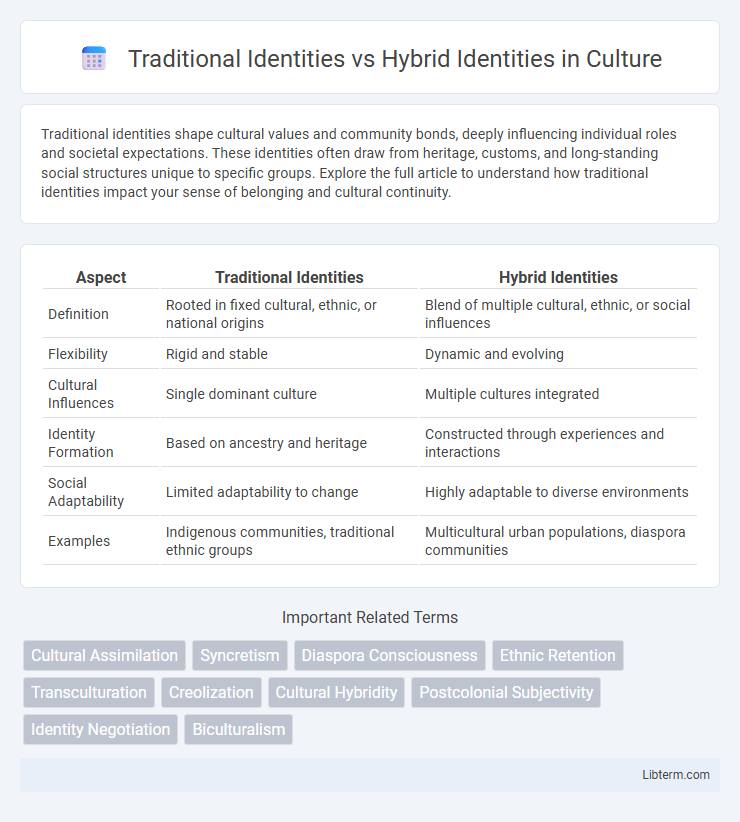Traditional identities shape cultural values and community bonds, deeply influencing individual roles and societal expectations. These identities often draw from heritage, customs, and long-standing social structures unique to specific groups. Explore the full article to understand how traditional identities impact your sense of belonging and cultural continuity.
Table of Comparison
| Aspect | Traditional Identities | Hybrid Identities |
|---|---|---|
| Definition | Rooted in fixed cultural, ethnic, or national origins | Blend of multiple cultural, ethnic, or social influences |
| Flexibility | Rigid and stable | Dynamic and evolving |
| Cultural Influences | Single dominant culture | Multiple cultures integrated |
| Identity Formation | Based on ancestry and heritage | Constructed through experiences and interactions |
| Social Adaptability | Limited adaptability to change | Highly adaptable to diverse environments |
| Examples | Indigenous communities, traditional ethnic groups | Multicultural urban populations, diaspora communities |
Introduction to Identity in a Globalized World
Traditional identities are rooted in long-standing cultural, ethnic, or national affiliations, often emphasizing stable and hereditary characteristics. Hybrid identities emerge from the blending of multiple cultural influences, reflecting the dynamic interactions and interconnectedness of globalization. In a globalized world, identity becomes fluid, shaped by migration, technology, and transnational exchanges, challenging rigid notions of belonging and emphasizing adaptive, multifaceted self-definitions.
Defining Traditional Identities
Traditional identities are defined by long-established cultural, ethnic, or national characteristics that emphasize continuity, heritage, and shared customs passed down through generations. These identities often anchor individuals to specific geographic regions, languages, and collective historical narratives. The preservation of traditional identities stresses maintaining consistent values, rituals, and social roles that reinforce community cohesion and a sense of belonging.
Characteristics of Hybrid Identities
Hybrid identities blend elements from multiple cultures, languages, and social backgrounds, creating fluid and dynamic self-representations. These identities challenge fixed boundaries by embracing diversity, adaptability, and multiplicity, often reflecting globalization and transnational experiences. The key characteristics include cultural hybridity, linguistic versatility, and a flexible negotiation of belonging within different social contexts.
Historical Roots of Identity Formation
Historical roots of identity formation reveal that traditional identities often stem from long-standing cultural, ethnic, and religious affiliations shaped by ancestral lineage and geographical boundaries. Hybrid identities emerge through historical processes of migration, colonization, and globalization, blending distinct cultural elements into multifaceted personal and group identities. Understanding the evolution of these identity forms requires analyzing the interplay between inherited traditions and transformative socio-political dynamics over time.
Cultural Influences Shaping Identity
Traditional identities are deeply rooted in long-established cultural norms, practices, and historical backgrounds that shape individuals' sense of belonging within specific ethnic or national groups. Hybrid identities emerge from the blending of diverse cultural influences, often resulting from globalization, migration, and intercultural exchanges, which create complex, multifaceted identities that challenge singular definitions. Cultural influences such as language, rituals, family structures, and social values intricately shape both traditional and hybrid identities by reinforcing belonging or enabling adaptation across multiple cultural contexts.
The Role of Migration and Diaspora
Migration and diaspora significantly shape hybrid identities by blending cultural elements from origin and host countries, contrasting with traditional identities anchored in a single cultural heritage. Hybrid identities emerge through ongoing interactions between migrants and diaspora communities, fostering dynamic, multicultural self-conceptions. This fluid identity formation challenges the fixed boundaries of traditional identities, reflecting global mobility and transnational experiences.
Media and Technology in Identity Evolution
Traditional identities often rely on fixed cultural, ethnic, or national markers reinforced through localized media channels that emphasize shared histories and collective narratives. Hybrid identities emerge through digital media platforms and global technologies, enabling individuals to blend multiple cultural influences and create dynamic, fluid self-representations. Social media algorithms and virtual communities facilitate identity evolution by allowing real-time interactions and personalized content that challenge conventional boundaries of identity formation.
Challenges Faced by Hybrid Identities
Hybrid identities often confront challenges such as cultural dissonance, social exclusion, and identity ambiguity, complicating their sense of belonging. Balancing multiple cultural norms can lead to internal conflicts and external misunderstandings from traditional identity groups. These challenges impact mental health, social integration, and access to community resources for individuals with hybrid identities.
Social Acceptance and Identity Conflict
Traditional identities often provide clear social roles and community acceptance, reducing identity conflict through shared cultural norms. Hybrid identities blend multiple cultural influences, which can enhance personal flexibility but may increase experiences of social ambiguity and identity conflict. Social acceptance for hybrid identities depends on the inclusiveness of the broader community and the recognition of complex identity narratives.
Future Trends in Identity Construction
Future trends in identity construction emphasize the growing prevalence of hybrid identities that blend cultural, digital, and social dimensions, challenging traditional identity frameworks rooted in fixed, singular categories. Advances in technology, especially augmented reality and AI-driven personalization, enable individuals to craft multifaceted identities that evolve dynamically across virtual and physical spaces. This shift fosters more fluid, context-dependent self-representations, reflecting globalization, migration patterns, and increasing interconnectedness in society.
Traditional Identities Infographic

 libterm.com
libterm.com